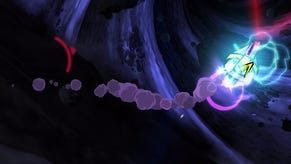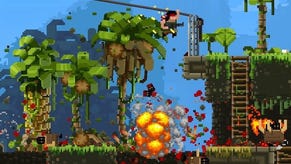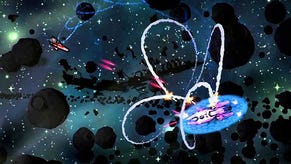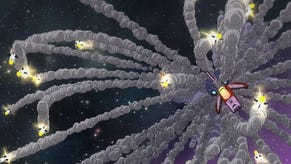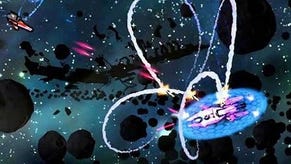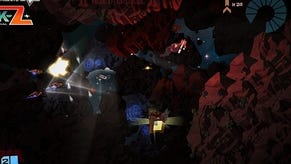Outer space is wild in Galak-Z
Kaboom.
Oh, this is new. When you die in Galak-Z - and you will, you will - the Game Over screen offers a rather chilling sight: your cheery 80's sci-fi space helmet tumbling through the cosmos bound for parts unknown, paint missing and screen cracked. Death is new, too, of course, at least this kind of death is. Since its unveiling at E3 in 2013, Galak-Z has changed in a very interesting manner, switching from a 2D dog-fighting open-world space game to a 2D dog-fghting roguelike space game. A juke to the left, and it alters pretty much everything.
It works, too. It really, really works. The shift in focus has allowed developer 17-Bit to retain the stuff that was already singing - the exploration, the upgrades, the seat-of-the-pants combat as you flip and twist and lock-on and blast - but it's also heightened everything. Each battle here could be your last, scrubbing not just the current mission, but a chassis-load of upgrades you've picked up over the last half hour, and so your laser fire feels tentative, as if you're shuffling into the cruel darkness, fingers outstretched and probing. Galak-Z already made space beautiful, with its neon greens and hot pink lasers bouncing off rocks, with its G-Force cast and its hand-painted explosions, but the roguelike element makes space cold and frightening, too. When the story tells you that you're the only survivor of the mother of all space battles - the last starfighter, in essence - you now believe it. You're piloting a nimble little craft decked out in racecar paint, but you're also managing weakness.
Having played the current build straight for a day or two, this is a game that offers bold strokes of brilliance along with tiny, glinting details that stick in the memory. On the bold side, the controls are wonderful, employing as Asteroids-styled point-and-thrust system that requires at least ten minutes to properly get to grips with. Tumbling through the ether, your craft can feel wilful, which means it also feels powerful. Master its strange momentum and you're able to duck in and out of battles with real precision.
Blasting things is equally elegant, with standard lasers joined by a paint-and-release system that's straight out of Rez, which 17-Bit's Jake Kazdal worked on back in the day. Your ship is the focus for much of the roguelike's cruelest love, too. You can upgrade different elements of it back at the shop if you pick up enough scrap, but you lose it all forever when you die and have to go back to the start again. Double lasers and a reinforced hull can mean an awful lot in this cruel wilderness, and you're as flimsy as a space fighter should be, too, with shields that take an agonising time to recharge and a hull that can't wait to pick up damage and spring a leak.
Progression is pretty straightforward. Each mission advances the plot, which so far hinges on you steadily gathering resources to patch your mothership back together after a real intergalactic shoeing. Missions are procedurally juggled in terms of objectives, but they generally see you warping into an asteroid belt before heading inside a really big rock, which acts a little like a dungeon. You never know what you're going to find in there, because each one twists and turns in its own way. These places are beautiful and intricate, and they're filled with environmental hazards that may prove useful in a fight. Lava pools: they can send forth little bubbles of boiling goop if you stir them to life with lasers. Space dandelions can release sticky spores that slow you down until you shake them off. At one point, I was hugging a wall a little too closely and a giant beetle-type thing came out and tried to drag me down into a pit. It was properly frightening. Wonderfully so.
Throw in different enemy races, all of which swarm and flock and threaten to overwhelm you in a dazzlingly reactive display of AI, and you've got a fairly punishing game, but one that has kept me coming back for one beautifully crafted explosion after another. Despite the shift in genre from the turn-based battles of Skulls of the Shogun, there's no doubting that Galak-Z is a 17-Bit game. It has the same precision, the same careful framework of critical thought that brings new life to an existing template. And it has the same wildness, bursting forth from the interaction of a handful of carefully chosen pieces. That's it, really: space is wild in Galak-Z, and I'm going to spend a lot of time over the next few years trying to explore as much of it as I can.



